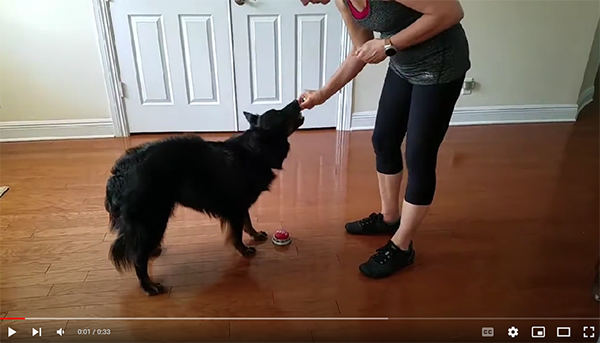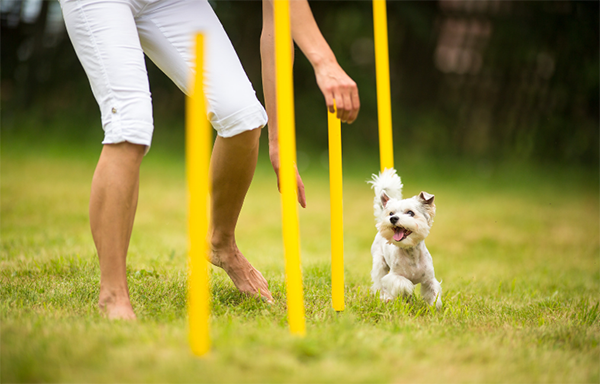The Science of Pleasure.
Whether your goal is to have fun with your dog, compete in a dog sport, or just want a well-trained companion, here’s how to turn your dog into a training addict!
It’s interesting how much we have in common with our dogs and other animals. The brilliant neuroscientist, Robert Sapolsky did a behavior experiment with monkeys. He was looking at the pleasure centers of the brain and specifically the neurochemical dopamine. He explained how monkeys and humans commonly generate the highest levels of dopamine when pleasure is anticipated, not when pleasure is actually experienced.
To determine that, he had monkeys pushing levers. After a certain number of pushes a light would come on and then the next push would generate a food reward. He measured the dopamine output in the monkey’s brain and discovered that it went up the highest when the light flashed. This was in anticipation of the pleasure of the reinforcement.
Here’s where it gets really interesting. When the monkeys got the reward only 50% of the time their dopamine levels went through the roof. Evidently, the word, “maybe” is very addictive. The uncertainty of the reward makes dopamine increase.
For those of you who are science-y, here’s a short and very captivating video of Dr. Sapolsky on this topic.
Controlling the timing and frequency of rewards can make your dog very motivated!
This is why humans play slot machines. What happens when you put money into a slot machine and it doesn’t pay out? You put more in. In fact, the longer you sit there, without winning, the more sure you are that the jackpot is coming. The slot machine strings you along with almost, but not quite, break-even payouts and you keep playing because you’re sure it’s going to pay off. This is called variable reinforcement and it can make behaviors stronger in dogs too. By using variable reinforcement, the dog trainer becomes the slot machine. You can create a little gambling addict – a dog that keeps playing the game because he believes that the reward will come if he plays long enough. The dog will work harder for less reinforcement.
It sounds pretty good, right? Maybe. As behaviorist Karen Pryor states, “Once a simple behavior has been learned, a long and unpredictable schedule can in fact maintain behavior that you DON’T want, with incredible power.” (If you’re interested in reading more about reinforcement schedules, click here. She is an author and educator specializing in behavioral psychology.)
How can an unpredictable reinforcement schedule backfire?
When your dog pulls you on walks and you move forward allowing him to pull, you are reinforcing (strengthening) the behavior. If you decide to teach your dog not to pull and you stop moving when he pulls forward (or you go the other way) you will teach him to walk politely, right? Not so fast. To change the behavior, you will need to be very consistent because if you allow him to pull occasionally, you are now using a variable reinforcement schedule and he will learn to pull you like a freight train. Oops!
As humans, we often naturally train with variability. When our dogs respond to a cue slowly and reluctantly we tend to be disappointed and the dog is not reinforced well or at all. However, when our dog responds with enthusiasm and exhibits brilliance at the task, we become very excited, use high praise and give out many treats in a row (called a jackpot). In this way, our dogs learn what generates the greatest and most valued reinforcement.
What works effectively for teaching new behaviors?
The best way to build new behaviors is to reward your dog every time he does the behavior correctly. This is a continuous reinforcement schedule. Don’t be stingy and don’t be in a hurry to move to a variable schedule. Every time the behavior is performed you should reinforce it. Reinforcement strengthens behavior. Your dog gets rewarded and he wants to do it again. Build the behavior in a low-distraction environment, and then build in more and more challenges.
We use a clicker to train new behaviors because it’s extremely precise and dogs can learn 40% faster! Every time the behavior occurs you click and then follow with a treat. The click predicts the treat. The dog performs with a better understanding. I believe the click might even create an anticipatory dopamine surge like when the light flashed for the monkeys.
Here is a short video demonstrating clicker training a dog to a new skill, in this case, my Aussie mix Runi. The skill is interacting with the Staples Easy Button. We train mostly in silence, allowing her to process the information received by the click and treat, but sometimes when a dog does something really well it’s hard not to also enthusiastically praise, a reinforcer that you’ll see in a video later in this post that Runi really responds to.

Watch this video to see Runi’s training progress. I am using a process called shaping. I waited patiently and clicked Runi for any correct step in the process of learning the behavior I was building and wanted to strengthen, and then followed the click with a treat. She progressed quickly to earn a desired treat.
You start teaching the dog in easy steps so she can be successful and has a desire to continue. When she gets good at that easy step you will raise the criteria to improve the behavior and make it a little harder. Now the reinforcement schedule is a little less predictable. The requirements are a little different and your dog will not be reinforced every time. Again, quoting Karen Pryor, “Reinforcement may go from predictable to a little unpredictable back to predictable, as you climb, step by step, toward your ultimate goal.”
For a dog who is a new learner, this unpredictability can cause him to give up. That’s why it’s important to allow your dog to learn at his level and not make things too difficult too quickly. You can lower your criterion (go back a step in learning and make it easier), ask for something he knows how to do well, or wait and try again at a later time or day. Build up his confidence slowly to create a dog that loves to learn and learns quickly.
I often hear from frustrated pet parents about how their dog does this or that behavior perfectly at home but acts like it’s new in the classroom setting. For your dog, it just might be! Dogs don’t generalize well so if all of their learning takes place in the kitchen at home, doing it at dog class might look completely new.
Every task we teach our dogs will have several different levels of complexity from very simple, to very difficult. One of the most common mistakes made by dog owners is to try and climb those levels too quickly.
To not build frustration in your dog, or you, be aware of the 3 Ds of dog training: Duration, Distraction, and Distance. They come into play in every context and all training exercises. As soon as you change the factors influencing the task, factors we call the 3 Ds, you affect your dog’s chances of success. (Many people wonder how super-effective dog trainers get such amazing results. Learn more about Using the 3Ds to Supercharge Your Training!)
The other factor to consider is the type of reinforcement you are using. Here’s some homework for you. First, identify your dog’s primary reinforcers, those things your dog wants and will work hard to attain. It could be a favorite toy, a specific kind of food (identify each one your dog likes and rank them), playing tug or fetch, social interaction such as petting and praise, or something he wants to do in the environment such as lizard hunting or foraging in the grass.
Second, rank your list of reinforcers from low to high. Which ones have the highest value to your dog? Match the reward to the behavior being trained and the situation. For example, in a highly distracting environment and you know that your dog’s focus will be different and more difficult to maintain, use a very high-value reward. (The subject of reinforcement is critically important to success. Learn more about using it, here.)
Here’s a video of my dog, Runi, retrieving the newspaper. I always reinforce this behavior, every time she does it. Sometimes she gets a food treat and sometimes she gets praise and petting. Not all dogs value praise/petting. Runi values it highly. But I always reinforce the behavior and she does it joyfully. Check out this video.

Watch the video. Runi loves being given tasks! Okay, maybe I went a little overboard with the praise while filming but you can see how much she enjoys it. She’s happy to do the behavior now for a lot less. The behavior has been so highly reinforced that she would do it without the promise of a reward. (Warning: unless your dog is highly trained and reliable, do not work off-leash in unsecured locations.)
One of my other dogs, Decker, does not really care for either praise or petting. Here he is doing a behavior that he knows and he is receiving a mid to lower level food reward, banana. His favorite reinforcement is something that is activity-related such as chasing a ball or playing tug. If we were working in a very distracting environment or I was asking for a difficult behavior I would choose one of those, or a high-value food reinforcer such as chicken.

Watch the video. It’s not hard to get the concept of giving a food treat for a job well done, but I wanted to include this video because Decker is pretty cute and always enthusiastic!
So, according to Dr. Sapolsky, how do humans and monkeys (and dogs) differ? It’s the lag time that makes the difference. How much lag time can there be between the work and the reward to still elicit the behavior? An extremely long lag time is uniquely human. Humans can maintain high anticipation levels for literally decades waiting for their reward. However, for your dog, keep ’em coming!


